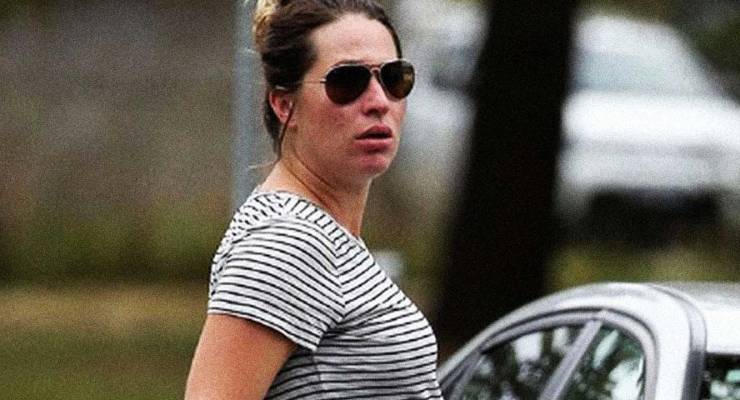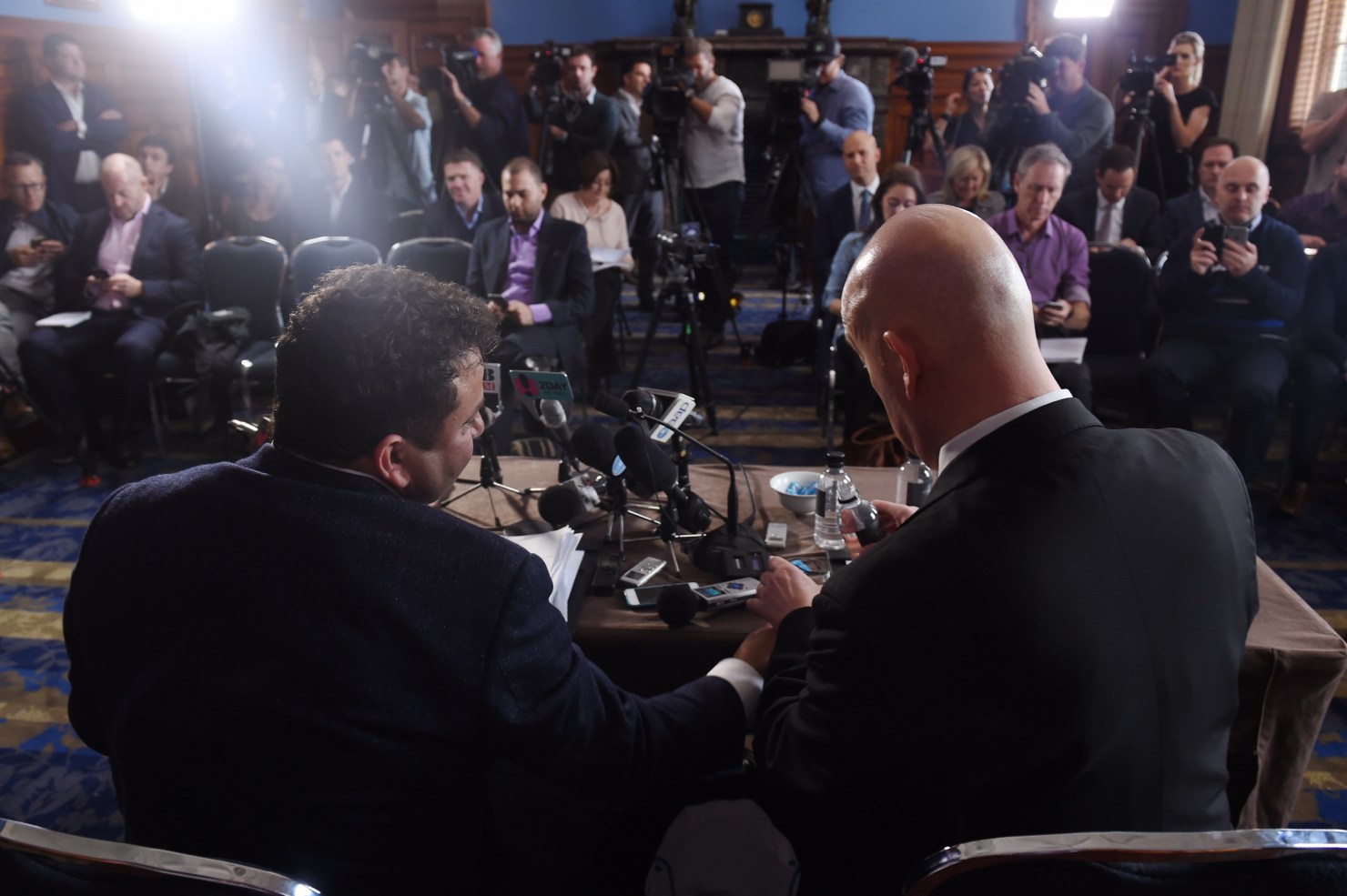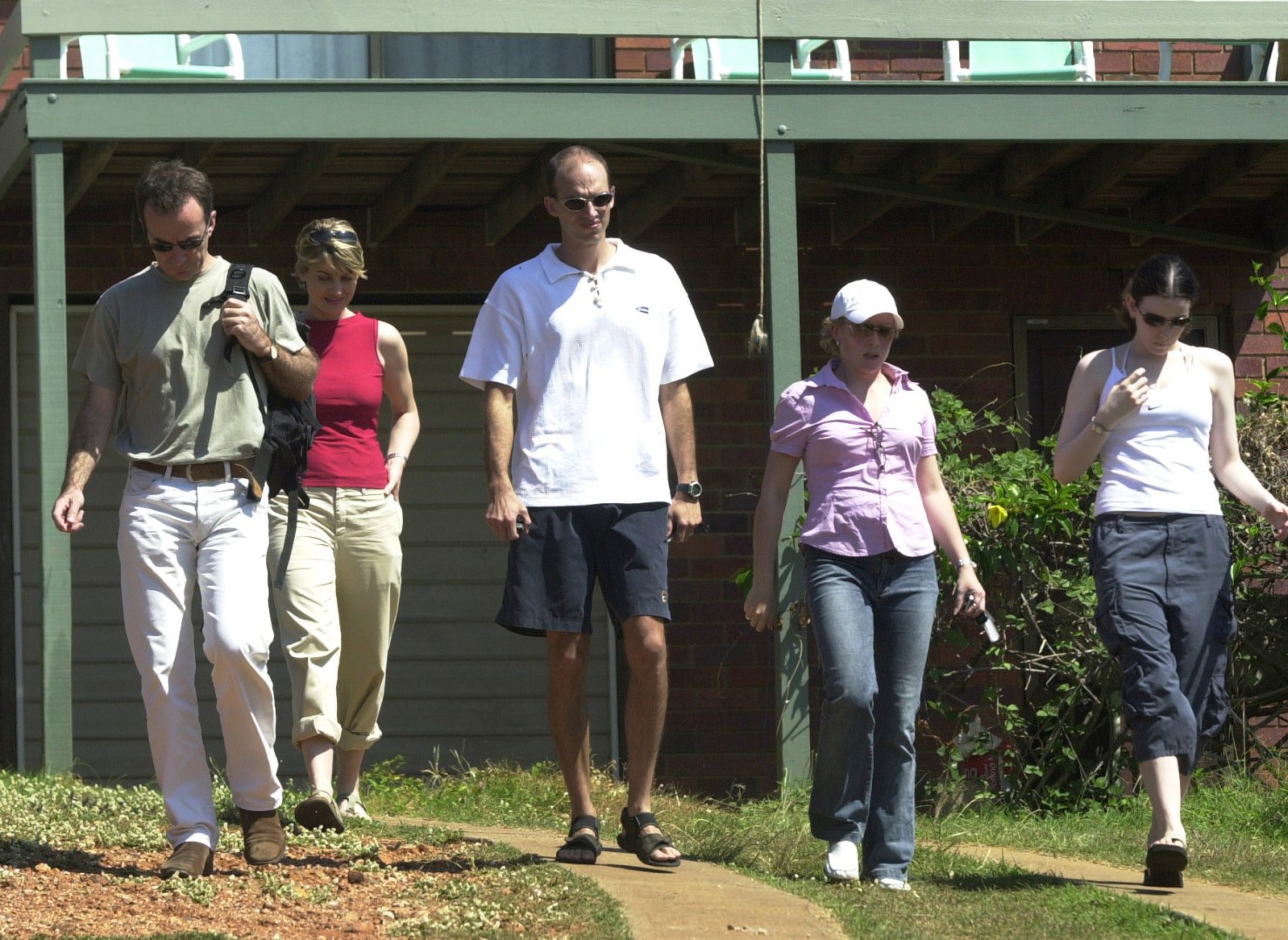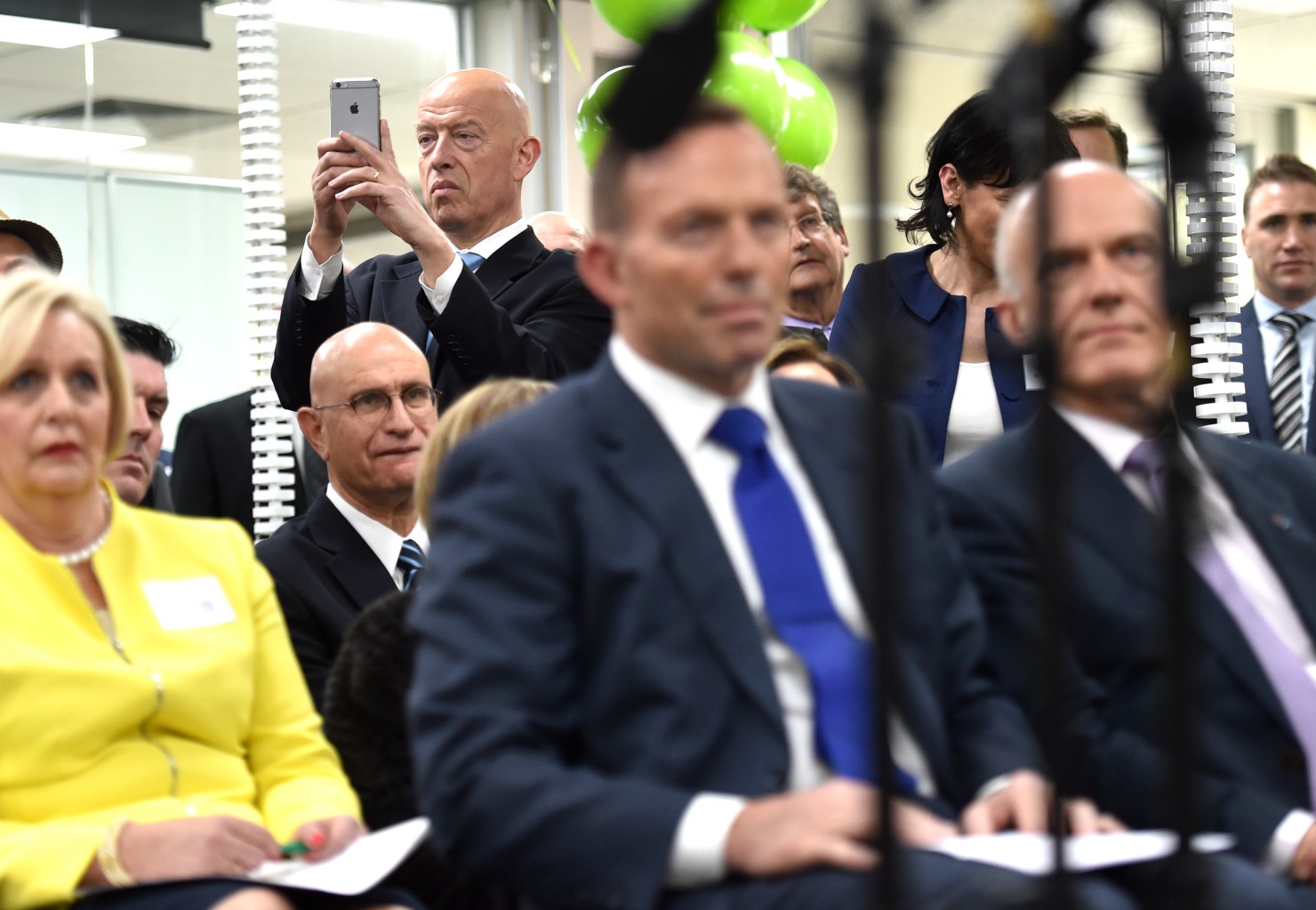
Schoolgirl Natasha Ryan had risen from the dead. Days into serial killer Leonard John Fraser’s trial for her murder, police discovered Ryan hiding in a cupboard. She’d run away from home, and stayed away for almost five years. Her family, and the authorities, presumed her dead. So when she turned up, alive, the race was on to cover the story. And to make some money from it.
Wherever there is a media scrum — reporters, camera operators and soundos jostling against each other for up to $2000 a day each — there’s someone looking to get a return on their investment. At the very centre, interviewees are also often paid. The news outlets telling their stories profit in ratings — which they can in turn boast to their advertisers; there’s dog food that needs to be sold, and this informs a chief of staff’s decision-making about resources, stories to chase, and cheques to write.
But what’s less known is the shadowy secondary economy that orbits the media. The agents that negotiate the interviews, “hone the message”, sell the tell-all book, book the nightclub appearances and clean up the crisis also take a cut. Lawyers are engaged for advice on a particular case — “chasing ambulances” not just for injury and compensation, but for defamation and privacy. And some new players have even moved in to profit off the battle for keeping Google search results clear — we call them the online “scrubbers”.
Media roadkill can be big business, with profiteers ready to help (for a fee).
PR agents — the sultans of spin
Within two days of police discovering Ryan, celebrity agent Max Markson had flown out from Sydney to her home in Rockhampton. He found 16 journalists and cameramen on her front lawn, waiting for her to come out.
“If you’ve got TV crews outside your front door, camped out there, you don’t know what to do, you’re like a deer caught in the headlights,” Markson told INQ. “If your phone’s ringing off the hook what do you do?” His answer to that question is, predictably, to call him. “I never approach people, I really don’t. I watch the news like anyone else, and if the phone rings I answer it … If I get a phone call I answer it and I help people.”

He also takes a 20% cut of the fees he negotiates, which often involve cheque book journalism deals, where news outlets pay interviewees to speak to them. He sold Ryan’s story to 60 Minutes and Woman’s Day after a fierce — and controversial — bidding war. The deal was reportedly worth more than $200,000, and Ryan sold her wedding photos for another $200,000 to Woman’s Day in 2008. Markson said the money for the initial interview didn’t go to Ryan or the boyfriend she’d been hiding with — speculation at the time was that the money was paid to Ryan’s mother, who was also interviewed.

He sees it as a necessary and fair transaction, especially when news outlets are making money off the interviews. “The reason that a media organisation pays for a story is to have exclusivity,” Markson said. “If a journalist can get the story, they deserve exclusivity … You’re much smarter to do one interview [than a press conference]. If you do one and you’re like 95% of Australians who have a mortgage and a job, and you’re in the news because of something embarrassing or bad that’s happened, if you can get $50,000 or $100,000 for doing an interview, you’d take it … It’s better to be notorious and have some money in the bank than not.”

And even when they’re not negotiating paid interviews, PR agents will, for a fee, manage the press for people in the midst of a media storm. Mike Smith, a former editor of The Age, has represented Steve Vizard and Peter Hollingworth at the height of their public disgrace, but said he would never work with a client who wanted to be paid for an interview. “As soon as a client [says they want to get paid], for any purpose, and it’s usually early in the piece, that’s when I walk away,” he told INQ. “I can see circumstances where [paid interviews are] morally OK, but I think because of my previous profession, it’s distasteful to me.”
He usually works with lawyers who have clients who want a better go than the media is giving them.
Like most media managers, Smith, Markson and others that INQ spoke to say they are a necessary tool for people facing a media storm.
“Once the media watchdog gets the smell of blood in its nostrils, it becomes a bloodhound, and if you don’t address it, it gets worse,” Smith said. “Unfortunately the media and community interpret silence as guilt and if the story’s interesting enough they’ll do whatever to get more information if there’s a scarcity of information.”
News masquerading as ‘infotainment’
When Schapelle Corby was released from a Balinese prison in 2017, the world was watching. Every Australian news outlet had crews ready to tell the story of Corby’s return to her Gold Coast home after 10 years in prison on drug smuggling charges. The media pack tracked her after she landed in Australia, and vied for an exclusive interview. Queensland newspapers ran liftouts dedicated to Corby’s return, and TV networks ran hours of coverage pondering all the foods and pop culture references she’d missed in the last decade.
The news media don’t just jump on big stories for their news value, or to inform the public — it’s a marketing strategy, and if the ratings are high enough, it pays off in advertising spend in future.
“Sometimes stories are so big you can’t not cover it, whether it’s a good investment or not,” media analyst Steve Allen said. “They’re important for content and they’re important for bragging rights, and if it brings up the ratings, that enhances the audience average over the year which helps when it comes to negotiating sponsorships and advertising down the track.”
TV news veteran Peter Meakin, who led news coverage (and chequebook journalism deals) for Seven and Nine before his current consulting role at Ten, said he didn’t consider advertising revenue when negotiating paid interviews, but ratings were important for his shows’ brands. “The main motivation to buy an interview is because you think the audience will want to see it and it will rate, as well as the prestige of having the interview,” he says.
Sometimes there’s a direct correlation between ratings and payment, but some of the small payments, like five- or 10,000 dollars, I’m not sure in most cases there’s a ratings dividend. Sometimes against your better judgement it’ll attract a better audience.
Meakin even encourages those at the middle of a media storm to hire agents. “If someone is suddenly caught up in a major story through no decision of their own and they have no experience of their own, they can benefit from expert advice. I think they’d be well advised to do that,” he said. “Dealing with the media doesn’t have to be a bad experience.”
Lawyering up
If a PR agent isn’t negotiating interviews, it’s often a lawyer. Meakin said he often worked with lawyers when trying to bag an interview, and Smith is regularly brought on to work with his clients through their lawyers. Lawyers are also often the ones sending takedown notices, defamation concerns letters and complaints to regulators such as ACMA.
When Today Tonight aired footage of Split Enz drummer Michael Barker, doctored to make it appear he made derogatory comments about a young suicide victim, he used legal contacts to go after them for defamation, to get an apology and payout. But it was an investment, even for someone with his resources. He told INQ:
If I didn’t have the money at the time I don’t think I could’ve done it. It would’ve been terrible if I didn’t have those resources and contacts.
Others use the law to argue a breach of privacy, which is what the family of Molly Lord, killed in a quad bike accident, did. Her grieving family was invasively filmed in the moments after her death on their property, in breach of TV broadcasting standards.
Minter Ellison partner Peter Bartlett, whose firm’s clients include INQ, said there was no statutory right to privacy in Australia, but there were ways to get some news articles taken down, but usually only when they are inaccurate or defamatory, like in Barker’s case. Defamation is a notoriously expensive pursuit, but Bartlett said it tended to be pro-plaintiff in Australia and many firms offered pro-bono representation if you had a good chance of winning.
“If you want something removed, the first thing would be that you would approach the host website to ask them to take down for various reasons but there’s no doubt that it’s difficult to have content removed especially if the host content is in the US,” he said. “Even if you sue in Australia no US court would recognise Australian judgements because of their right to free speech.”
The internet has a long memory that’s often impossible to escape
If you Google “Sharon Tarrant”, the first image result is a screenshot of her son, Brenton, from his video just before he murdered 51 Muslims at Friday prayers in New Zealand. The other first-page images are paparazzi shots of her in the hours and days after the massacre (taken without her knowledge or consent). More than half the first page of results is about her and her relationship to her son. A prompt appears to redirect your search specifically to “Sharon Tarrant (Brenton Tarrant’s mother)”. And there’s not much she can do about it.

When a person finds themselves swept up in a media storm — even a small one — the coverage isn’t limited to TV and radio broadcasts, or even newspapers that get thrown out. It’s all there in perpetuity on the internet in news articles, video clips and social media posts. And it can be saved and re-published, and screenshot and shared, over and over and over again.
“It’s very common for social media or mainstream media to receive requests to take down material on the basis of inaccuracy,” Bartlett said.
There’s no statutory right to privacy in Australia … (and) the Australian Law Reform Commission looked at whether we should introduce that right to be forgotten in Australia (which exists in the European Union) and recommended against it. They took the view it would have a chilling effect on free speech. In reality it would be an attempt to rewrite history.
But that’s not the view of Internet Removals director Zach, whose surname is withheld for safety reasons. His company charges clients to try to get stories taken down, rather than go through lawyers. Since 2011 they have had over 2,500 clients. They trawl through website terms and conditions and country-specific laws for the host websites, to try to get posts taken down. Other companies manipulate online searches to bury negative stories and boost other search results.
A small case will cost around $550, compared to what he said was closer to $1500 for a takedown letter sent by lawyers, and tens of thousands of dollars if the cases go to court.
Zach said some clients had faced severe depression, anxiety and had been driven to suicide because of information about them online. He said he knew of a psychology student who was charged for misrepresenting herself as a qualified psychologist. The woman was allegedly in an abusive relationship, which the court noted, and was trying to make money to support her spouse. A news article about her being charged, however, stayed online. She was “sleepless” about it and the woman eventually took her life. “We’ve seen people begging for the right to be forgotten, basically,” he said.









When ordinary citizens encounter journalists, it’s often unexpectedly, at times when they’re vulnerable, and without any knowledge or preparation for what might occur and how profoundly it might affect their lives and relationships.
This series will help readers become better prepared, and perhaps foster public discussion about how to what media ethics ought to be, and how to improve them. Thank you for another quality article.
This is the in-depth reporting that Media Watch could be doing. Thank you.